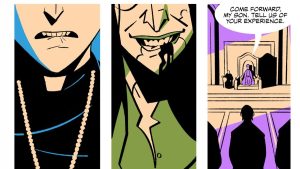There are some games that lock into their fan base and refuse to let go — and this sports game from 24 years ago still plays in my head rent-free. The third entry in the EA Sports BIG line of titles, SSX Tricky was a rousing success for the publisher and proof that the arcade sports game still had a place in a gaming ecosystem that was increasingly embracing more realistic takes on the genre.
Becoming something of a snowboarding answer to something like the Tony Hawk series, SSX Tricky stood out for more than just the tight snowboarding gameplay, however. The game’s colorful cast, expansive maps, and killer soundtrack made it unforgettable, especially for a generation of gamers who bought the title to go along with the newly released GameCube and Xbox. Almost a quarter century since it first hit shelves, players still love SSX Tricky — and it’s hard to blame them for it.
SSX debuted in 2000 as the first entry in the EA Sports BIG sub-line of titles, but it was the sequel game, SSX Tricky, that really hooked gamers. SSX was a launch title for the PlayStation 2, helping push the new series into gamers’ hands. Two more EA Sports BIG titles were planned for 2001 following that success. Released earlier in 2001, NBA Street was an addictive evolution of games like NBA Jam. Meanwhile, SSX Tricky built on the success of the previous game in some phenomenal ways.
Initially planned as an expansion more than an outright new game, the title was originally called SSX DVD and was meant to incorporate expanded takes on SSX‘s maps. Characters would be given more personality with voice-overs, and a graphical update would create crisper looks. However, during development, the game received an overhaul and was built out further to become its own game. While the first SSX had been a fun arcade riff on a snowboarding game, SSX Tricky embraced the larger-than-life elements to an extreme degree.
The playable characters became more distinct and the levels more colorful. Players could deploy signature Uber Tricks, which gave the game a larger-than-life spirit. In-race rivalries could be developed between the player and certain CPUs, causing opponents to become more aggressive during races. This focus on in-race sabotage and showmanship plays into the “extreme” spirit of the game’s presentation and underlines just how much the approach differs from other, more realistic sports games.
The EA Sports BIG sub-series was one of the most entertaining moves that the publisher ever embarked on. While franchises like Madden continued to push the sports simulator in a realistic direction, gamers who preferred the madcap chaos of NBA Jam or NFL Blitz were left with fewer options. Relying more on the visceral thrill of arcade-style sports games instead of the in-depth realism of console titles, games like NBA Street, NFL Street, and Def Jam Vendetta introduced approaches to sports genres that were underscored by the music, fashion, and culture of the era.
SSX Tricky was the key to that approach, especially given its turn-of-the-century focus on extreme sports, spiky hair, and aggressive coolness. It felt perfectly of the time, but with enough cartoonish broad appeal to be a certain level of timeless. The focus on fun gameplay over tight realism benefited the snowboarding genre, with players encouraged to take unlikely paths towards victory. Absurd special tricks became a constant of the gameplay, especially in the stages designed around grinding, half-pipes, and massive jumps.
Launching on the PlayStation 2 on November 5, 2001, SSX Tricky soon became a cross-platform hit when it also came to the Nintendo GameCube and the Microsoft Xbox. The game sold incredibly well with fans, eventually earning “Platinum” status on the PS2. It did well with critics, who noted the similarities to SSX but celebrated the improvements to gameplay and the expansions in terms of playable characters and levels. SSX Tricky came out for the GameCube less than two weeks after the Nintendo console launched in the United States, helping cement it as a must-play launch title for a generation of Nintendo fans. Same with the game’s port to the Xbox, which only came out a few weeks after that one launched as well. To a generation of players, SSX Tricky is a core memory of their experiences delving into the broad horizons of new consoles.
SSX Tricky remains a fan favorite decades later. It shouldn’t be surprising, given the success of the title with critics and general audiences across consoles. It was memorable and colorful, with tight controls and a solid presentation. I mean, it’s also probably partly the song. As soon as the game loads up and hits players with a blast of Run DMC’s “It’s Tricky,” the exciting vibes have already set in.
Alongside a host of memorably fun playable characters and vibrant maps, SSX Tricky was an absolute blast. Levels like “Tokyo Megaplex” were a blast to explore for their full trick potential, while maps like “Alaska” offered an exciting challenge for even the most hardened of players. SSX Tricky was also one of the rare games that I experienced that didn’t seem to hit the kind of cultural walls that other multiplayer titles had.
Gamers of all ages, colors, and genders could get behind the aesthetics and controls, with a range of playable characters helping bring an extreme edge to the sports space. The mix of races and trick-based challenges, as well as the solid multiplayer options, made it a surprisingly replayable title. While there have been other SSX games, there hasn’t been another one that could quite match the lightning-in-a-bottle vibes of SSX Tricky. 24 years later, I still remember getting SSX Tricky along with my GameCube and playing it endlessly — and I know I’m not the only one with a similar experience. There’s a reason fans have been holding out hope for a remake for years, but at least we’ll always have that first experience of pulling off an Uber Move for the first time and hearing Run DMC celebrate our success with the title song.
The post It’s Been 24 Years, and I’m Still Obsessed With This Wild Sports Game appeared first on ComicBook.com.




